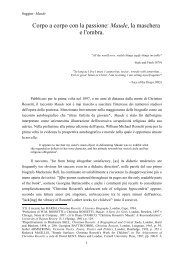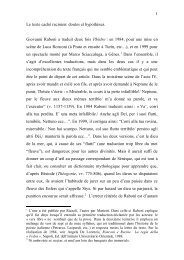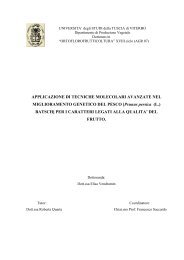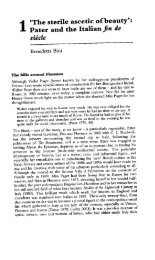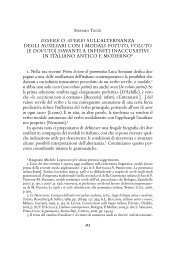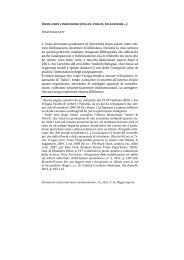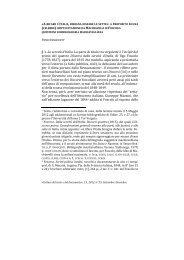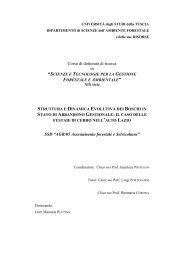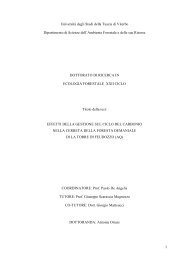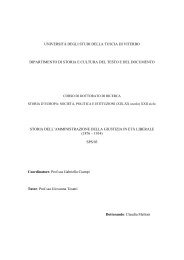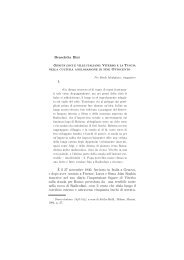drivers of soil respiration of root and microbial ... - Unitus DSpace
drivers of soil respiration of root and microbial ... - Unitus DSpace
drivers of soil respiration of root and microbial ... - Unitus DSpace
You also want an ePaper? Increase the reach of your titles
YUMPU automatically turns print PDFs into web optimized ePapers that Google loves.
3.2.4. Data analyses <strong>and</strong> definition <strong>of</strong> terms<br />
74<br />
The 13 C signature <strong>of</strong> belowground <strong>respiration</strong> <strong>and</strong> total <strong>respiration</strong> were combined with the<br />
measurement <strong>of</strong> CO2 concentration in the respective flask. These allowed estimating the fractional<br />
contribution <strong>of</strong> the belowground <strong>respiration</strong> to the total one, <strong>and</strong> then applying a two-source mixing<br />
model, to estimate the 13 C signature <strong>of</strong> the aboveground <strong>respiration</strong>:<br />
13 Ctot =((f* 13 Cb)+((1-f)* 13 Ca))/1 (eqn. 1)<br />
where, 13 Ctot, 13 Cb <strong>and</strong> 13 Ca is the 13 C signature <strong>of</strong> total, below <strong>and</strong> aboveground <strong>respiration</strong><br />
respectively, <strong>and</strong> f is a fractional contribution <strong>of</strong> each <strong>of</strong> the component to the total <strong>respiration</strong>.<br />
As the continuous measurement <strong>of</strong> the <strong>soil</strong> <strong>and</strong> total CO2 efflux were not available, we<br />
assumed that the <strong>respiration</strong> rates <strong>and</strong> 13 C contributions from all the sources varied linearly between<br />
the measurement events. These allowed estimating the total amount <strong>of</strong> 13 C respired during the<br />
period from 1 hours to 10 days following the application <strong>of</strong> the label (Carbone et al., 2007).<br />
The total label recovered (TLR) was defined as the calculated sum <strong>of</strong> the label ( 13 C, g) from<br />
below- <strong>and</strong> aboveground components between 1h <strong>and</strong> 240h after pulse labeling. This quantity was<br />
defined as a 100% for each labeling. The below <strong>and</strong> aboveground components were then partitioned<br />
into percentage <strong>of</strong> TLR.<br />
The fraction <strong>of</strong> <strong>respiration</strong> from label (FRL) for below <strong>and</strong> aboveground components was<br />
defined using the same equations as described by Carbone et al. (2007) <strong>and</strong> Carbone <strong>and</strong> Trumbore<br />
(2007). The isotope mass balance approach was used to partition the fraction <strong>of</strong> <strong>respiration</strong> coming<br />
from the label:<br />
FRL = ( 13 Cs - 13 CB)/( 13 CL - 13 CB) (eqn. 2)<br />
where 13 Cs is the measured sample <strong>respiration</strong>; 13 CB - is the background <strong>respiration</strong> signature,<br />
13 CL is the label signature. 13 CL was estimated as the measured mean 13 C <strong>of</strong> CO2 during the 1h<br />
labeling period.<br />
The mean residence time (MRT) <strong>of</strong> the label in the below <strong>and</strong> above ground components<br />
was calculated fitting an exponential decay function to the FRL. All the data were separated in two<br />
periods for the better fit <strong>of</strong> the exponential curve. MRT represent the time which is required for the<br />
amount <strong>of</strong> label to be reduced to 1/e times <strong>of</strong> its initial value. Using the data <strong>of</strong> TLR <strong>and</strong> MRT was<br />
calculated the mean age (MA) <strong>of</strong> respired C (Carbone <strong>and</strong> Trumbore, 2007):<br />
MAs = (TLRs(0-24h)*MRTs(0-24h) + TLRs(24-240h)*MRTs(24-240h))/TLRs(0-240h) (eqn.3)




